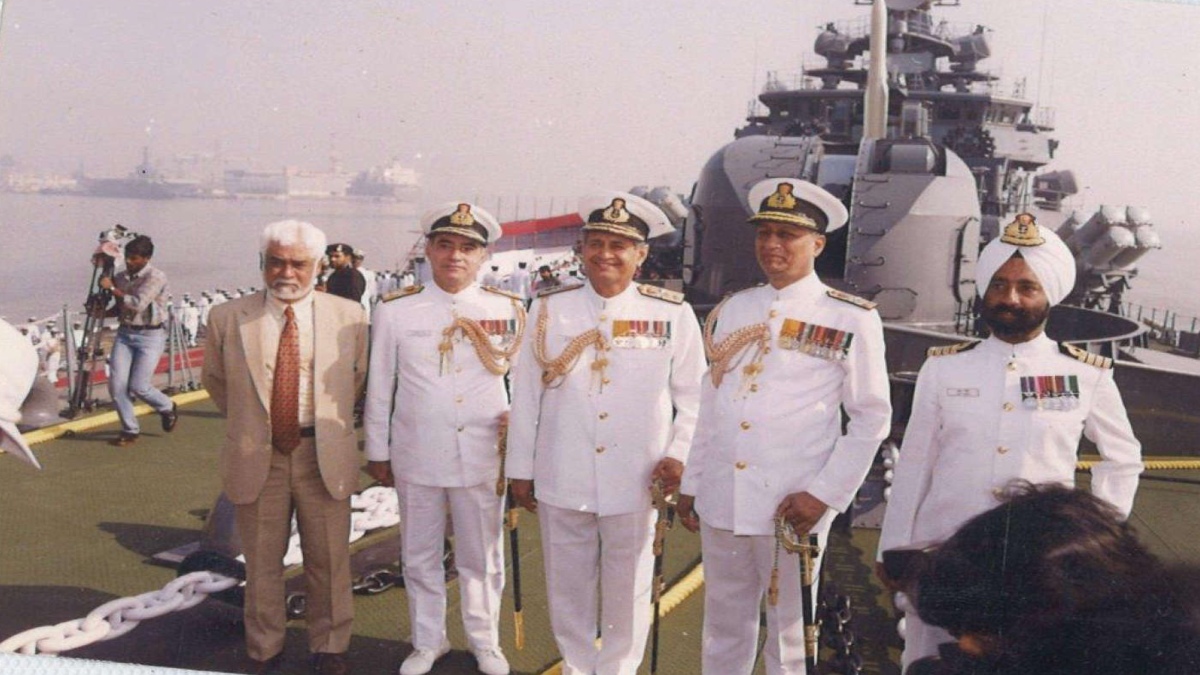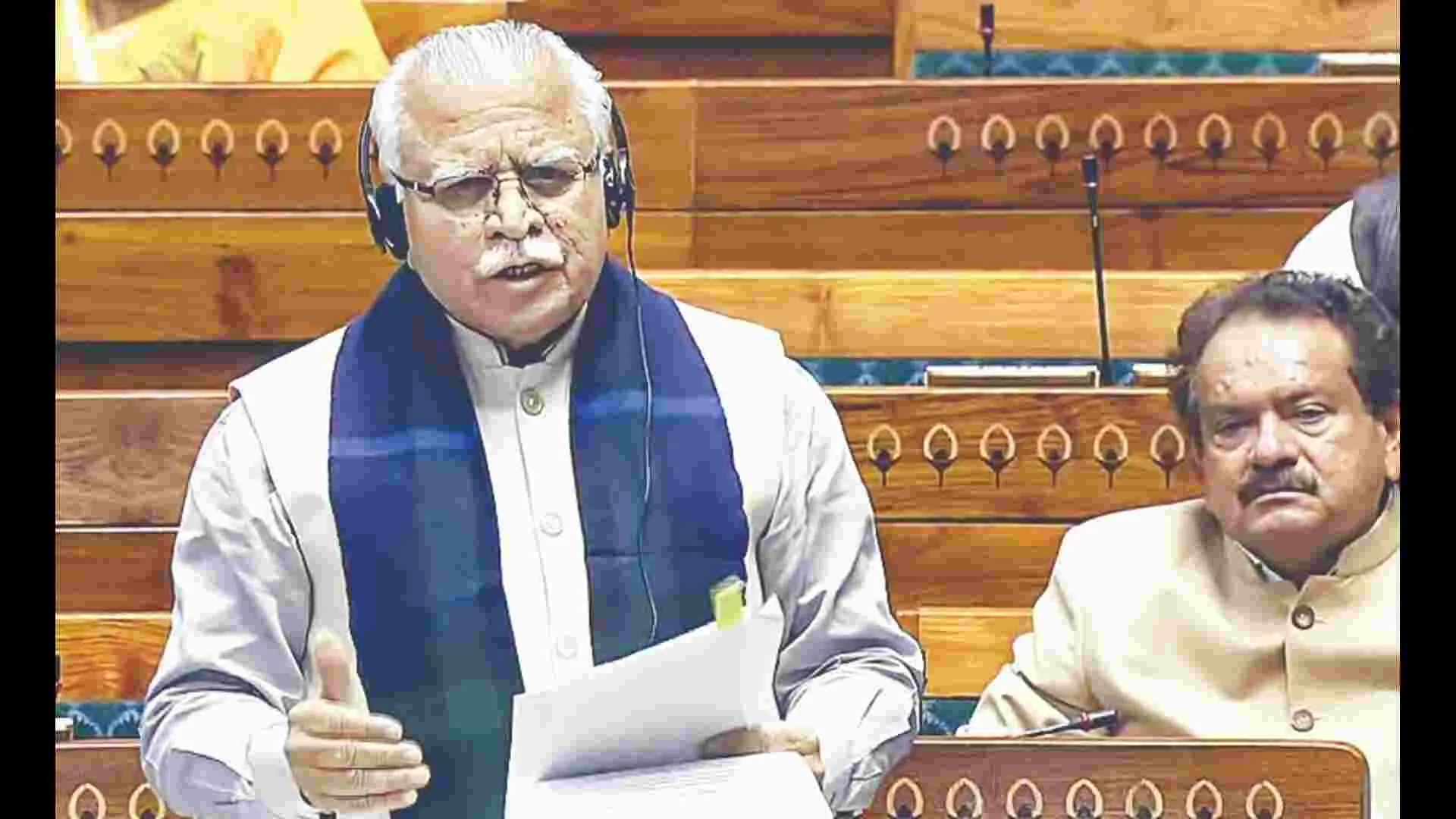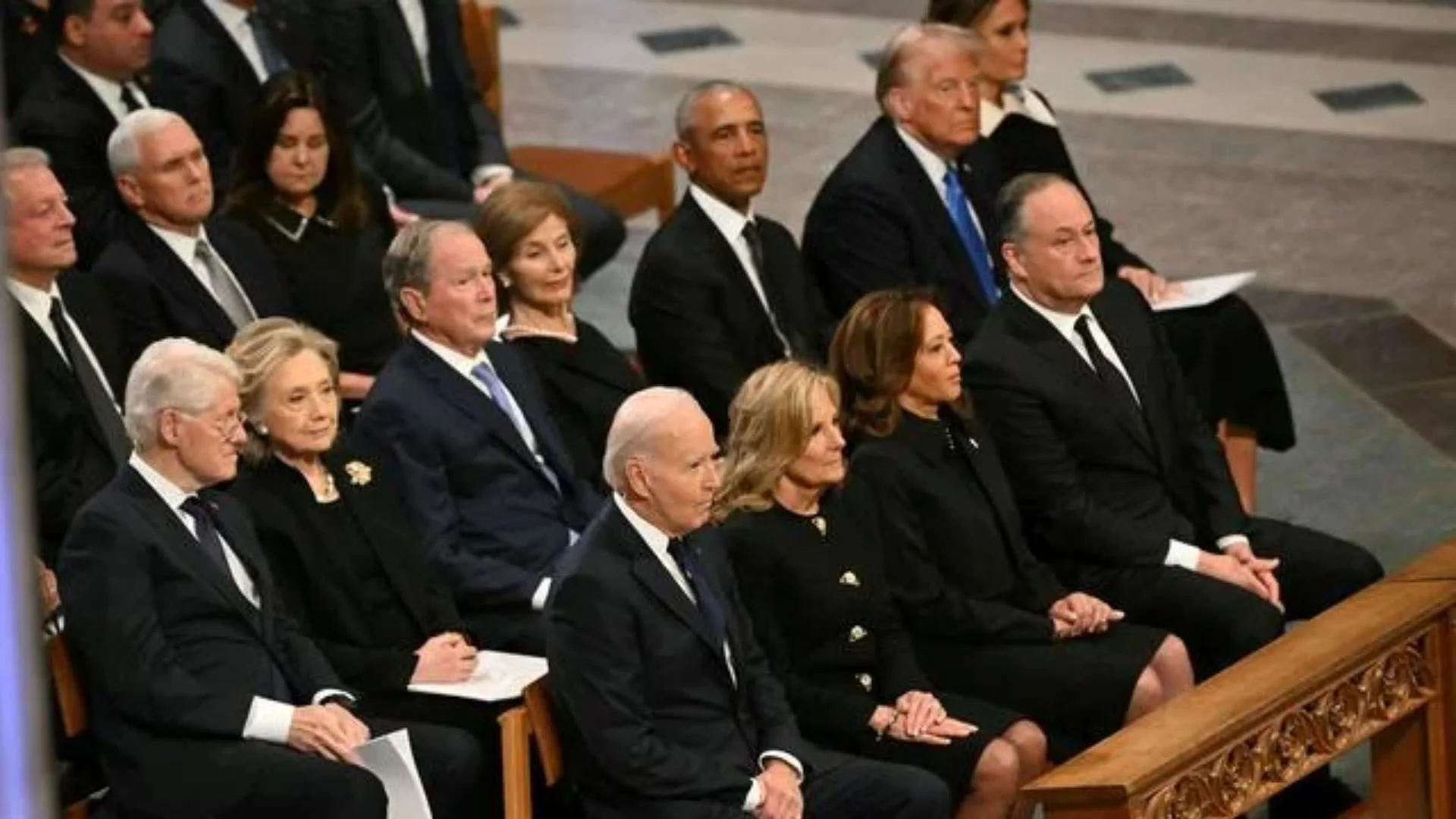Tomorrow, Sunday 21 Nov, the Indian Navy will commission its latest Guided Missile Stealth Destroyer (DDG) INS Visakhapatnam in the Naval Dockyard at Mumbai with the Defence Minister Shri Rajnath Singh as the Chief Guest. Apart from the novelty of naming a ship after a leading port city of India, of which a little later, Visakhapatnam, with its advanced, state of the art suite of weapons and sensors represents a formidable combat unit comparable to the best of DDGs globally. It also represents a landmark moment in the Indian Navy’s relentless quest for indigenization and self-reliance in warship building.

INS Visakhapatnam at sea.

INS Visakhapatnam.

INS Delhi and INS Mysore, the first avatars.

INS Delhi commissioning on 15 November 1997.

INS Visakhapatnam crest.

INS Visakhapatnam mascot Blackbuck, the state animal of Andhra Pradesh.

INS Delhi top view.
The ship is the first of the Project 15B series of four destroyers – named Visakhapatnam, Mormugao, Imphal and Surat that the Navy intends to commission in the following years. These follow the Project 15A or the Kolkata class ships – Kolkata, Kochi, Chennai which joined the Fleet in the last decade and which, in turn, were a follow on the Project 15 (Delhi class) ships – Delhi, Mysore and Mumbai that were commissioned between 1997 and 2001. All the destroyers have been built or, will be, in Mumbai city, at the Mazagon Dock, which over the years has become the premier warship building yard of the country.
A warship is amongst the most complex things constructed and, therefore, warship building is the holy grail of infrastructure technology. Like missile, space and nuclear technologies, warship building is the preserve of few nations among whom India is one. While the aircraft carrier is the queen of the maritime theatre, destroyers are powerful surface combatants with multi-dimensional capabilities. Equipped with an array of weapons and sensors they can be effective in all domain warfare – surface, anti-air, anti-submarine and electronic. Typically, in the range of 5000 to 10000 tons displacement, they also possess long endurance so as to operate singly or in small task forces or as part of the Fleet. In short, the destroyer is an extremely versatile platform capable of essaying the full spectrum of naval roles – warfighting, constabulary, diplomacy and benign – and is, therefore, a very important piece in the maritime chessboard. To put it somewhat simplistically, Cruisers or Light Cruisers performed this role after World War 2 but, over a period of time, destroyers have come to become the most formidable assets in any navy’s Order of Battle (ORBAT).
Immediately after independence, Indian Navy began a process of expansion. Guided by visionary founding fathers, a force of ‘less than half dozen sloops’ embarked on the journey of building a powerful Navy, as the principal guardian of India’s maritime interests, in the post-colonial era. Embedded in this vision were two key principles – the first, to enhance Fleet strength by rapid induction of platforms from abroad as necessary for its enhanced mandate of more than ‘coastal defence’ as was prescribed in the colonial times and, the second, a sound commitment to indigenization by transitioning, at the earliest, from a buyer’s navy to a builder’s navy. In other words, despite the complexities of warship building, the advanced technologies required and lack of adequate industrial capacity in the country at that time, the Navy was determined to build locally, by acting as a catalyst for creation of such capacities as required. This desire attained even more urgency as naval budget, in the initial years after independence, remained tight owing to commitments for the other two services in view of continental threats and wars.
Indian Navy’s indigenization or ‘atmanirbharta’ journey can be summarized as one of several phases with each succeeding one being a big leap over the previous phase. The first phase began in 1960 with the commissioning of a small Seaward Defence Boat, INS Ajay and culminated with the building of INS Darshak, a survey ship. The second was when we constructed weapon platforms with the six Nilgiri class frigates from late 60s to early 80s. These ships were built to the British Leander design, albeit with some improvements with every new ship. So much so, that the last two ships were described as ‘stretched Leanders’ owing to their ability to take the bigger Seaking helicopter as against the Chetak helicopter that the earlier ones embarked. The ‘Nilgiri’ class also had the first surface to air missiles, the rudimentary ‘Seacat’ system and an advanced Action Information Organization (AIO) in the operations room. The next phase was the construction of the three Godavari class guided missile frigates in the eighties, when a completely Indian design came into play. Using the best of both Western and Soviet philosophies that we had been exposed to and amalgamating that with equipment from several other nations we created a unique Indian design. Equipped with surface to surface and surface to air missiles apart from guns and torpedoes, the Godavari class was characterized by sophisticated sensors and an integrated AIO system, as well as a helicopter deck that could carry two Sea King helicopters. The latter with their own considerable organic capabilities were referred to as ‘flying frigates’ and heralded force multiplier effect into the fleet. While the Navy had always had an in-house design organization since inception, which had further expanded with the Nilgiri project, the Godavari class ships were built as designed by the naval design bureau and this was a paradigm shift in our indigenization journey.
Arguably though, the next phase was the biggest leap. While the Godavari class frigates were impressive, they were ‘works in progress’ which found culmination in the Delhi class destroyers. The Delhi class, called Project 15, was our ambitious design to create state of the art ships that could be workhorses like destroyers and also provide command and control facilities of a cruiser. The three ships inducted between 1997 and 2002 had sleek looks, imposing silhouette, armament and equipment that were a huge jump from those existing in our inventory and were great advertisement for our ship building prowess. It was the Delhi class design that segued, with considerable improvements, into the Kolkata class or the Project 15A destroyers of the last decade and now seamlessly transition, with further enhancements, to the Visakhapatnam class of the Project 15B.
It is important to emphasize that this is not the only thread of our indigenization story. Other lines such as the Khukri class missile corvettes, the Shivalik class stealth missile frigates, the Kamorta class ASW corvettes, Patrol Vessels, Amphibious ships, Tankers, Missile Boats, Seaward Defence Boats, Survey vessels and training ships have embellished the catalogue of our designers and builders and each of these ships are in service or have served the country with distinction. Submarines and aircraft carrier building adds a whole new dimension, deserving a separate article. However, to the extent that a genre tells a story, one may argue that ‘Delhi to Visakhapatnam’ journey is a continuum and is a phase of accelerated ‘atmanirbharta’. It’s also a journey made exciting by the names of the ships and their linkages with key events in the country.
Naming of ships is an interesting separate essay in itself. Much thought goes into the endeavour and it is not the intention to dwell on that here. But some history may be useful to join the dots. India’s first Flag ship, acquired from Britain, in Jun 1948, was named INS Delhi. INS Mysore, also from Britain, followed a decade later. Both were erstwhile Royal Navy cruisers which had earned their spurs in World War 2 as HMS Achilles and HMS Nigeria respectively. Delhi and Mysore, capital ships named after capital cities, provided our fledgling Navy, much combat capability while also acting as nurseries for the growth of our leadership. It is no wonder they (along with INS Vikrant, our first aircraft carrier) were regarded as iconic ships embodying the growth of the Indian Navy in the first few decades after independence and our gradual transformation into a big navy.
Thus, the reincarnation of the Delhi class in 1997, now in an indigenous avatar, was welcomed by all and seen as a wonderful omen. There were three ships in this class and third was named Mumbai not only to represent a capital city but also celebrate the long lineage of ships that had been named Bombay/Mumbai and built in colonial times. Delhi, Mysore and Mumbai induced awe, nostalgia and reverence. Along with the aircraft carrier Viraat, these played the role of flagships and command and control platforms with aplomb and gave our navy a much greater reach and capability than hitherto. It was, thus, natural to name the follow-on destroyers after other capital or big cities – Kolkata, Kochi, Chennai, Visakhapatnam, Mormugao, Imphal and Surat. Except for Imphal all other names are port cities that blend antiquity with modernity and are a perfect fit for navy ships which combine tradition and technology. Imphal, on the other hand, is a salute to the North Eastern part of India and recognition of that region’s contribution to national security and its cosmopolitan ethos. It is the first Indian warship named after a city in the North East which is a landlocked region. In doing so, the Navy is also suggesting that no region in the country is ever removed from the sea, especially in the interconnected globalized era.
This nautical tradition of naming a man-of-war after a city has created umbilical links between the city and the ships. It has vitalized the relationship between the residents of a city and the seafarers serving onboard its ‘namesake’. Hence, let us return to Visakhapatnam, the protagonist of this story.
Often referred to as the ‘City of Destiny’, Visakhapatnam’s history dates to the 3rdcentury BCE, when it was part of the Kalinga kingdom and was involved in extensive international maritime trade. Varying tides of fate saw its control transferring from the regional rulers to Mughals, and then to Europeans, until India’s Independence in 1947. For the British, Visakhapatnam served as the perfect natural harbour to transport mineral wealth from central India to Madras and Calcutta Presidencies. The harbour was opened to trafficin 1933.
Visakhapatnam (also called Vizag, Visakh, Waltair) and the Indian Navy have had an enduring relationship. Realizing the strategic importance of its location in the Bay of Bengal, the British established a small naval station in 1939 as an assembly point for their convoys. HMIS Circars was commissioned subsequently as an operational and refitting base, with few small warships being positioned and the establishment of an ordnance depot and Boat Repair Shop. Visakhapatnam assumed great significance with WW II spilling over into South East Asia. It was a major supply and transit point of the Allied powers for the Burma front.
Post-independence developments saw further expansion and the setting up of a base repair organization in the fifties. The city became the Headquarters of a full-fledged Eastern Naval Command (ENC) in March 1968. 1971 was an eventful year, with the Indo-Pak conflict, in which the ENC played a pivotal role as the key headquarters of war orchestrating actions at sea and ashore to dominate the Bay of Bengal and engineer a decisive victory. The locals too had their share of war experience with the sinking of the submarine PNS Ghazi, occurring just off Visakhapatnam harbour on the night of 03 Dec 71. Over the last fifty years, the ENC has grown rapidly in size and stature. It has become the nerve-centre for orchestrating India’s naval influence in the Eastern and Southern Indian Ocean Region. The city’s strategic location provides the Navy with a vantage position from which it overlooks the world’s busiest shipping lanes. The myriad and potent naval assets at Visakhapatnam enable presence in India’s maritime areas of interest, besides projecting the Indian Navy as the Preferred Security Partner in the region. The city boasts of a distinctive maritime character. Its striking skyline features the Dolphin Hill Lighthouse, Visakhapatnam Port Trust, Kursura submarine museum, TU-142 and Sea Harrier aircraft museum, and the 1971 Victory at Sea Memorial, all of which stand testimony to its rich maritime legacy. For Vizagites, the enduring presence of the Navy has been a source of assurance, besides being an extension of their nautical traditions and aspirations.
Visakhapatnam, the ship, 164 meters long and displacing 7500 tons, is one of the largest surface combatants to be built in India. She is a versatile unit capable of Blue Water operations across the spectrum of warfare. Her sophisticated weapon-sensor suite, coupled with network-centric capabilities makes her a potent Command platform that can bring to bear substantial offensive capability. Armed with advanced Surface-to-Surface supersonic cruise missiles, she can undertake surface strikes at extended ranges. Her Medium Range Surface-to-Air Missiles, along with active phased array radar, represent a generational leap in the Navy’s Anti-Air Warfare capability. In addition, the 76 mm Medium Range gun and four each AK 630 and Close-Range guns provide effective Surface and Anti-Air capabilities at closer ranges. The ship has an equally potent Anti-Submarine weapon fit comprising latest heavy weight torpedoes and rockets.
Her air surveillance and surface search radars, bow-mounted and towed array sonars, electronic and COMINT systems provide a continuous multi-dimensional surveillance bubble around the ship. The ship’s survivability in combat is assured by multipledecoy systems. Most importantly, the Combat Management System integrates the ship’s diverse weapons and sensors with other ships, thereby providing seamless Maritime Domain Awareness, reduced sensor-to-shooter cycle, and cooperative engagement capability. Above all, the ship is capable of operating two multi-role helicopters which extends her surveillance and offensive capabilities, besides enabling Search and Rescue (SAR) operations. The main machinery features four powerful reversible Gas Turbines of 20000 HP each, propelling her at speeds in excess of 30 Knots. Likewise, a captive power generation capacity of 4.6 MW, along with sophisticated power distribution architecture, efficiently meets the energy requirements of the ship. An Integrated Platform Management System enables single point remote operation and control of all machinery including damage control and ventilation equipment.
The commissioning of Visakhapatnam tells many stories. First, the quantum leap in technology and capability that has propelled her into a league of new generation warships. Second, the predominantly indigenous weapon-sensor-machinery fit and stealth features symbolize the maturing of India’s indigenous shipbuilding capability and quest for self-reliance. In a milestone development, there are 39 ships or submarines being built in India over the next few years. Above all, it is a significant marker of the Indian Navy’s journey. If the first Delhi was inducted soon after independence and the second Delhi in the 50th year of the event, on 15 Nov 1997, Visakhapatnam is being commissioned, as we step into the platinum jubilee of independence.
Discerning readers may then ask where does Mumbai fit? Apart from having a destroyer by that name, Mumbai figures as the city where all these ships have been built and where, thus far, they have been home ported. Thus, one may conclude that the quarter century from Delhi (second) to Visakhapatnam via Kolkata and Mumbai has been one of accelerated ‘AtmaNirbharta’. Let us raise a toast to our planners, designers, builders, overseers and ship’s crew on this momentous occasion. Wishing Team Visakhapatnam attains glory in its tryst with maritime destiny.
Cmde Srikant Kesnur is associated with the Naval History Project. Views expressed here are personal.























